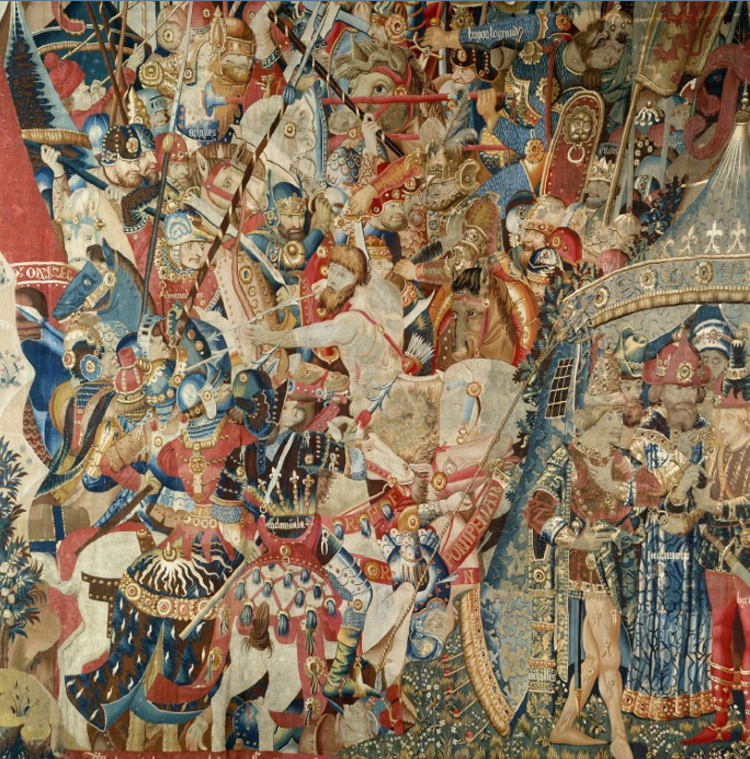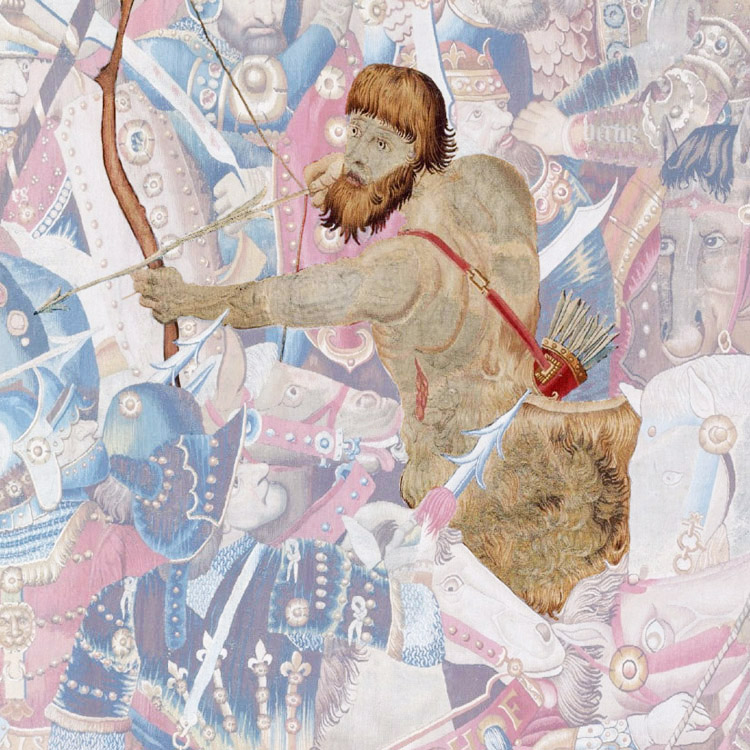I found a sagittary at the Louvre, searching the famed art museum's site for "centaur" hits. Take a look at this lovely fellow:

Check out the source page here: Medallions from a Coffer. These buckle-like strap-hinges were part of a small decorative box, dated 1175-85. The medallions were decorated in a lion theme. Three show people riding lions. And one shows a true liontaur. The text describes the figure as "centaur shooting an arrow," but if you look at the paws and tail, and compare those to the other lions in the set, there is no doubt that this is a liontaur, or sagittary, not a centaur.
17 April 2018 Update: Look! I found another Limoges enamel liontaur from the same time period (1150-1250), this time on a belt buckle:

I found this at the Portable Antiquities Scheme, a British Museum website that documents archeological finds in Great Britain. The page for this buckle describes it like this:
The elaborate enamelled decoration comprises a centaur (with the body of a lion rather than a horse) to dexter reguardant with shield (with traces of blue enamel in the centre and white enamel border) in left hand and club in right on a blue field. The head of the centaur is modelled in relief on the gilded head of a separate copper-alloy rivet (flattened on reverse), with traces of engraving delineating the features. The upper part of the centaur is filled with green enamel with bordering yellow enamel. The lion-like lower body has a bifurcated tail, a surviving patch of blue and white enamel on the upper part of the near foreleg and a patch of green and yellow enamel on the upper part of the near rear leg. Probably manufactured at Limoges.
I came across this short excerpt from a Harper Magazine column by Rafil Kroll-Zaidi that refers to a statue of a "sagittary" that comes to life with destructive effect:
"The emperor Leo the Wise prophesied the doom of Constantinople. (The dreams of man may come from God, accorded the science of the Muslims, but they may come also from the Devil, or from man himself.) Leo created a toad, or a marble tortoise, who roamed the streets at night and consumed all the city’s refuse. He built a bathhouse for the poor that was destroyed by its guardian sagittary statue when the bathkeepers began to charge admission."
Now, the word "sagittary" derives from the Latin word for archer, and as such, it might refer to a centaur, a liontaur, or even just to a human with bow and arrow. There's no way to know if the reference here is to a liontaur.
But it is interesting because the urmahlullu of Ancient Assyria were lion-centaur guardian spirits that protected palace "ablutions rooms" -- that is, bathing rooms. Now here is another sagittary guarding a bathhouse, thousands of years later: a survival from a distant time, or a coincidence? And let me stretch credulity even further to note that Leo, then as now, is a name associated with lions.
I have tracked down the reference in the story above, however. It is from pages 74-75 of Cyril Mango's "The Legend of Leo the Wise,” in the book Byzantium and Its Image. Mango is a retired professor at Oxford, and I've written, with no response so far.
Next up, here is a weaver's interpretation of the sagittary of the Trojan War, incorporated into a wall tapestry. The original, The Battle with the Sagittary and the Conference at Achilles' Tent, hangs in the Metropolitan Museum of Art in New York City. It was woven around 1470-90 in Holland, too early to have been influenced by Shakespeare's Dreadful Sagittary, but maybe coming from Guido of Colonne or Benoît de Sainte-Maure.
Take a look at the whole tapestry:

Kind of confusing, huh? Where's the actual sagittary? Here, let me zoom in and pop the beastie out for you to see:

Note that you cannot see tail or feet. Are those feet paws or hooves? The fellow's beard is very mane-like. His body fur is very curly and wild; to me that's more lionlike than equine. Compare especially with the coats of the horses in the tapestry. In the absence of any other clues, I like to think it is a liontaur.